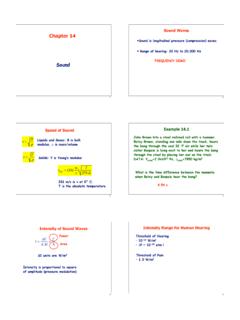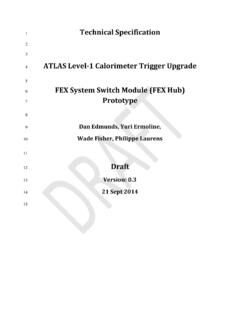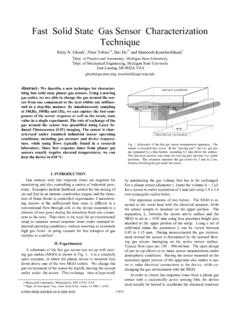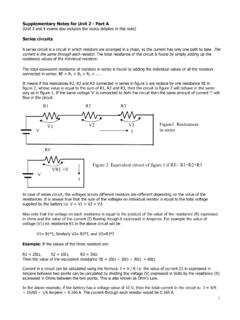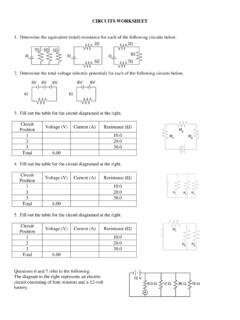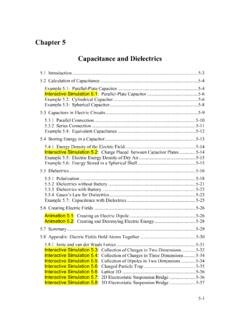Transcription of Ohm’s Law - Michigan State University
1 Experiment 2. Ohm's Law Objectives Become familiar with the use of a digital voltmeter and a digital ammeter to measure DC voltage and current. Construct a circuit using resistors, wires and a breadboard from a circuit diagram. Construct series and parallel circuits. Test the validity of Ohm's law. Reduce a complicated resistance circuit to a simple one- resistor equiv- alent circuit. Introduction In the US, most of us use electricity every day. That electricity is handled in circuits: a closed loop of conductors travelling from power plants to neighborhoods to households and back again.
2 That closed loop, with all of its many parts, forms one huge electrical circuit. Today we'll use the 3. essential parts of a circuit power supply (or battery), wires, and resistors. We'll learn how resistors a ect the current of electrons that flows through them, and how connecting resistors in di erent ways changes their behavior. 19. 2. Ohm's Law Key Concepts As always, you can find a summary on-line at HyperPhysics1 . Look for keywords: electricity and magnetism, ohm's law, resistor , resistor combina- tions To play with constructing circuits and actually see how the electrons flow through a circuit, check out the online simulation Circuit Construction Kit 2 from the University of Colorado.
3 Theory One of the fundamental laws describing how electrical circuits behave is Ohm's law. According to Ohm's law, there is a linear relationship between the voltage drop across a circuit element and the current flowing through it. Therefore the resistance R is viewed as a constant independent of the voltage and the current. In equation form, Ohm's law is: V = IR. ( ). Here, V is the voltage applied across the circuit in volts (V), I is the current flowing through the circuit in units of amperes (A), and R is the resistance of the circuit with units of ohms ( ).
4 Eq. implies that, for a resistor with constant resistance, the current flowing through it is proportional to the voltage across it. If the voltage is held constant, then the current is inversely proportional to the resistance. If the voltage polarity is reversed (that is, if the applied voltage is negative instead of positive), the same current flows but in the opposite direction. If Ohm's law is valid, it can be used to define resistance as: V. R= , ( ). I. where R is a constant, independent of V and I.
5 It is important to understand just what is meant by these quantities. The current (I) is a measure of how many electrons are flowing past a given point during a set amount of time. The current flows because of the 1. 2. 20 Last updated January 24, 2013. Theory electric potential (V ), sometimes referred to as the voltage, applied to a circuit. In much the same way that a gravitational potential will cause mass to move, the electric potential will cause electrons to move. If you lift a book and release it from a height (high gravitational potential) it will fall downward (to a lower potential).
6 The electric potential works in a similar way; if one point of the circuit has a high electric potential, it means that it has a net positive charge and another point of the circuit with a low potential will have a net negative charge. Electrons in a wire will flow from low electric potential with its net negative charge to high electric potential with its net positive charge because unlike charges attract and like charges As these electrons flow through the wire, they are scattered by atoms in the wire.
7 The resistance of the circuit is just that; it is a measure of how di cult it is for the electrons to flow in the presence of such scattering. This resistance is a property of the circuit itself, and just about any material has a resistance. Materials that have a low resistance are called conductors and materials that have a very high resistance are called insulators. Some materials have a moderate resistance and still allow some current to flow. These are the materials that we use to make resisters like the ones we will use in this experiment.
8 In short, the electric potential causes the current to flow and the resistance impedes that flow. Two or more resistors can be connected in series, connected one after another (Fig. (a)), or in parallel , typically shown connected so that they are parallel to one another (Fig. (b)). If the current can split ( there is more than one way for the current to flow) and then rejoin, they are in parallel . When two resistors R1 and R2 are connected in series, the equivalent resistance RS is given by RS = R1 + R2.
9 Thus, the circuit in Fig. (a). behaves as if it contained a single resistor with resistance RS that is, it draws current from a given applied voltage like such a resistor . When those same resistors are connected in parallel instead, we use a di erent formula for finding the equivalent resistance. See Table for all the necessary equations. 3. Note that we say the current flows from high poential to low potential, but electrons flow from low to high. This is because current is defined as the flow of positive charges, and electrons are negatively charged.
10 A negative charge flowing in one direction is like a positive charge flowing in the other. Yes, it's confusing, but we can't make the whole world start calling electrons positively charged, so we're stuck with it. Last updated January 24, 2013 21. 2. Ohm's Law (a) Series (b) parallel Figure : Schematics of circuits illustrating resistors connected in series and in parallel . Series parallel VS = V1 + V2 VP = V1 = V2. IS = I1 = I2 IP = I1 + I2. 1 1 1 R 1 R2. RS = R1 + R2 RP. = R1. + R2. or RP = R1 +R2. Table : Equations for two resistors in series and parallel .
